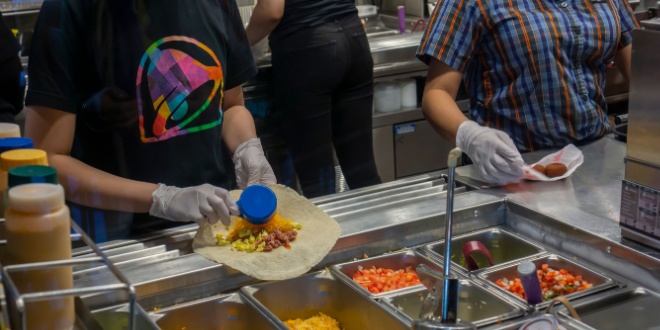At $16 an hour, California has one of the highest minimum wage mandates in the country.
Last September, the state got even more generous when Gov. Gavin Newsom signed into law AB-1228, which raised the minimum wage of fast-food worker to $20 an hour. That law, which was backed by the Service Employees International Union went into effect April 1.
“[AB-1228] gives hardworking fast food workers a stronger voice and seat at the table to set fair wages and critical health and safety standards across the industry,” Newsom said in a statement released when he signed the bill at an SEIU chapter headquarters in Los Angeles. “We’ve taken one step closer to fairer wages, safer and healthier working conditions, and better training by giving fast-food workers a stronger voice.”
Newsom doesn’t want to stop there.
He’s also proposed raising the minimum wage of health care workers to $25 an hour, a move that would happen incrementally between now and 2033. That was to have started this year, but Newsom decided to wait because California has a $45 billion budget deficit that must be dealt with first.
California’s base minimum wage is well above the federal minimum wage of $7.25 an hour. Newsom obviously wants to pay the state’s hourly worker something that resembles a livable wage, but some economists would advise him to drop that idea.
They argue that raising the minimum wage, under any circumstance, only succeeds in raising prices, ultimately reducing the incomes of low-income workers. It will also cut back on the number of jobs that a business can provide, which keeps entry-level workers from earning a paycheck and developing job skills.
Those are several arguments against a minimum wage hike, and they may be being proven correct in the aftermath of AB-1228 being signed into law, according a study released in June.
California’s Minimum Wage and the Long-Run Consequence tor the State’s Youth by Beacon Economics in Los Angeles noted that California’s unemployment rate is now the highest in the country, having risen by one percent during the past year and a half.
What’s more, most of the people who lost their jobs were less than 25 years old.
“Why are younger California workers being excluded from employment opportunities?,” the 24-page report asks its introduction. “Look no further than the state’s aggressive minimum wage mandates, (which are) policies that covers long-term as well as short-term affects.”
Even though California’s fast-food workers have been earning $20 an hour for only two months, it’s not too early to blame, at least partly, the state’s rise in unemployment on AB-1228 being signed into law, according to the report’s author.
“It’s true that it didn’t take affect until April 1, but the fast-food industry saw it coming,” said Chris Thornberg, founder and president of Beacon Economics. “They started planning ahead as soon as Newsom signed the bill. “If there’s another reason for the drop in youth employment, I’m not seeing it. No other explanation makes sense.”
Unlike some of Beacons’ research projects, the minimum wage study was not commissioned by an outside entity, public or private.
“I did this report on my own,” Thornberg said. “We [California] have a strong economy, and I’m always telling people that the state economy is doing better than the media says it’s doing. But when I looked at those numbers I saw that unemployment has been going up for the past year or so.
“I asked myself how that could be possible.”
When he looked at the bigger picture, Thornberg found that from April 2022 to April 2024, California’s jobless rate went from 4.2 percent to 5.3 percent. Those numbers were hard to accept for several reasons, according to Thornberg.
First, during that period, the national unemployment rate barely moved. Also, the state’s economy grew at a reasonable pace during that time: a three percent increase in economic output from April 2023 to April 2024, and 13.6 percent growth dating back to April 2019.
Finally, the state’s labor supply was static during that time. The number of job openings dropped slightly, but it remains higher than at any time before the pandemic.
Thornberg also found that much of the state’s unemployment was happening among people less than 25 years old. That led him to to the fast-food industry, in which about one-quarter of that demographic is employed, according to the U.S. Census Bureau.
“Fast-food is a good sector of the economy to look at,” Thornberg said. “Over the years, It’s become a right of passage for a lot of young people, mostly high school students. You get your first job at McDonalds, or someplace like it.”
The study cites a Beacon Economics report, which predicted a loss of minimum wage jobs if economic growth stopped and the minimum wage was raised too high.
“This is exactly what we’re seeing among younger workers in the state today,” the report released last month states. “We can expect the situation to worsen now that fast-food chains have been singled out for a $20 per hour minimum wage.”
One of the first signs of that “singling out” happened at the end of last year, when Pizza Hut announce it was laying off thousands of delivery drivers in California, including about 1,200 throughout San Bernardino, Riverside, Los Angeles and Ventura counties.
Operators blamed the $4 an hour raise given to the fast food industry, which one local economist called “too high,” although he declined to say by how much.
“This will definitely hurt young people who are looking for their first job, but I think the real question is why did this happen in the first place,” said Robert Kleinhenz, an economist who operates a private consulting firm in Long Beach. “A big part of the answer to that question is the cost of housing in California. We need affordable housing up and down the state, and we don’t have that.
“If we did we might not have such a high minimum wage.”
Some economists want to do away with the minimum wage entirely, but Thornberg does not agree with them.
“I have nothing against the minimum wage, but I don’t like Is this ‘one-size-fits-all’ approach that we take,” Thornberg said. Sixteen dollars an hour in San Francisco or Los Angeles is fine, but it should be $9 or $10 an hour in Fresno, because Fresno is a cheaper place to live.”
 IE Business Daily Business news for the Inland Empire.
IE Business Daily Business news for the Inland Empire.



The fast food is really not good you might give the workers there raise but the food is really bad it not tasting at all anymore. Especially Taco Bell it is sloppy and doesn’t taste great like it used to.